It seems we can’t find what you’re looking for. Perhaps searching can help.
Sign Up for newsletter!
Subscribe to get the latest eBook!
Hotline






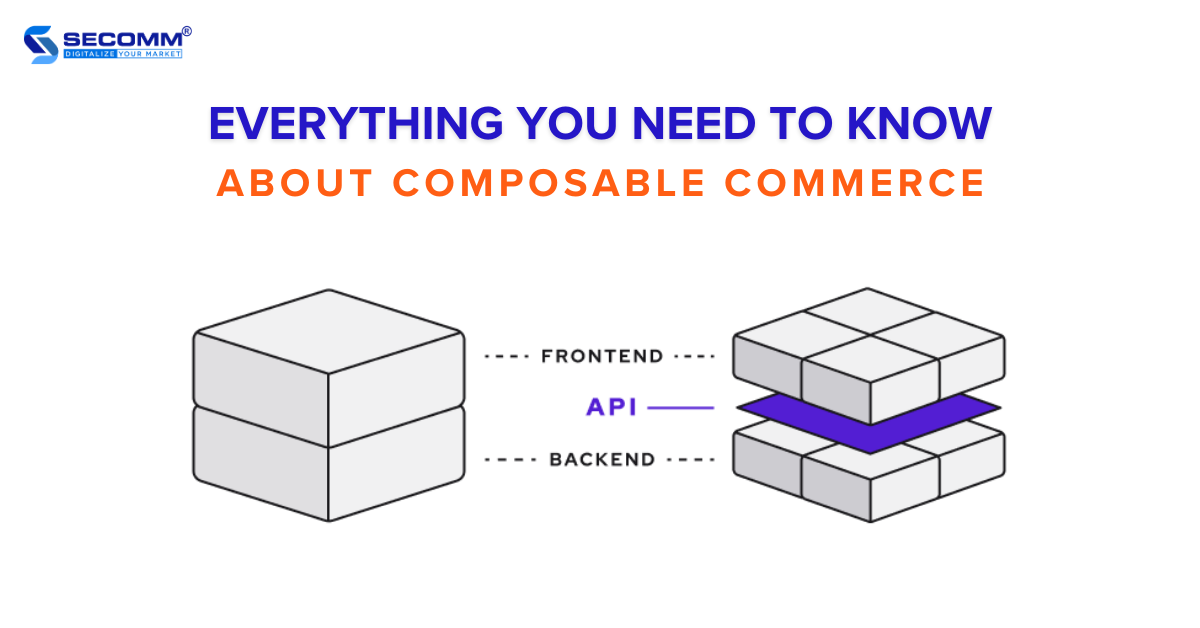
As Monolithic architecture solutions face flexibility, customization, and scalability challenges, businesses are increasingly exploring more adaptable architectures, like Headless Commerce.
Alongside this, the concept of ‘Composable Commerce’ has gained prominence as a robust model to cater to the evolving needs of businesses and the swiftly changing market.
So, what exactly it is, and how does it distinguish itself from Headless Commerce? Let’s investigate these aspects to comprehend why it might represent a revolutionary leap forward.
The term ‘Composable Commerce’ was first coined by Gartner Research in June 2020, referring to building a flexible and customizable e-commerce system by integrating various components to build distinct ‘Packaged Business Capabilities’ (PBCs) solutions tailored to the deployment needs. These PBC solutions can connect through APIs.
The PBCs may include:
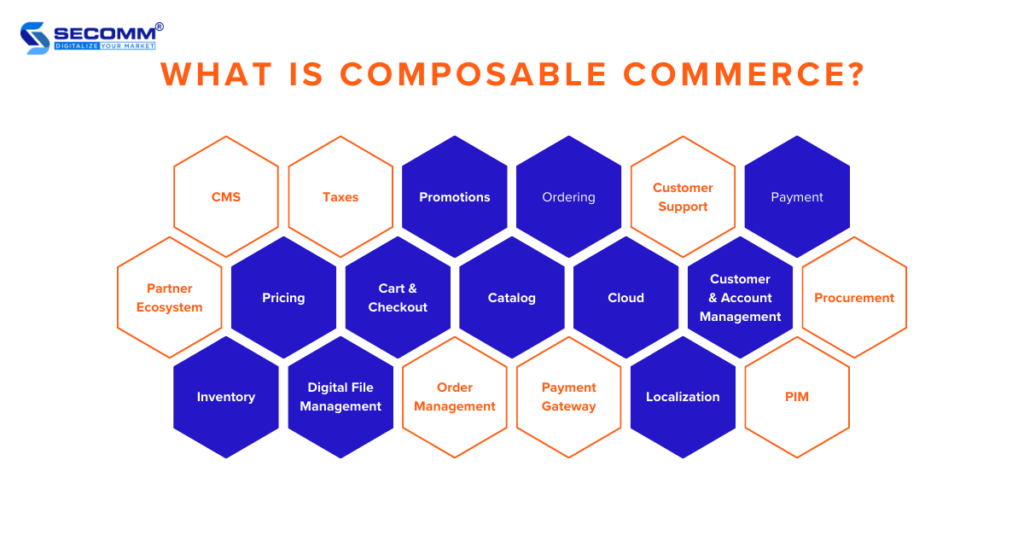
If we consider components as smaller and more intricate elements of the eCommerce system, PBCs represent the integration of each of these smaller components to craft a unique eCommerce solution tailored to each business. In this scenario, components are on an equal footing, and so are the PBCs.
Therefore, any modifications or expansions in any component or PBCs won’t impact the overall operation of the entire system.
To put it more simply, within the composable architecture, you build your eCommerce system much like assembling a Lego set.
Here, each PBC corresponds to a specific Lego block with a designated function. These blocks can seamlessly combine and link through APIs, resulting in a flexible and personalized eCommerce experience that aligns with your initial needs and wants.
Hence, the eCommerce development model allows you to attain the utmost flexibility and optimization for your eCommerce system.
Some benefits to highlight when adopting Composable architecture:
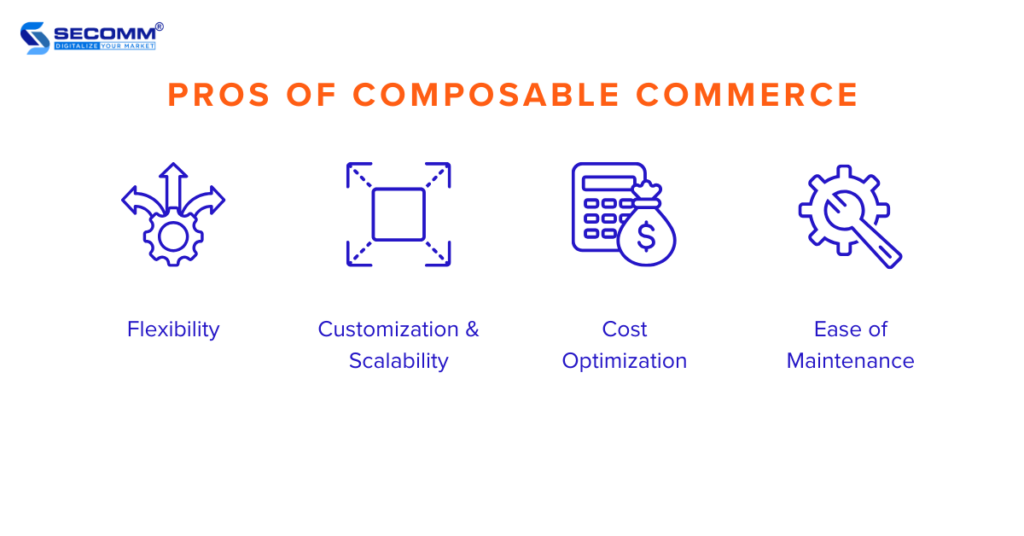
This eCommerce development model offers high flexibility. You can select to combine the most suitable components for your needs. This flexibility allows you to easily create an eCommerce system that adapts to market trends and ever-changing customer experience expectations.
The model can meet the highest demands for customization & scalability. You can freely customize each component based on your brand and what you want for customer experience. But you can also scale individual components to handle growing traffic and transaction volumes.
This level of customization and scalability allows you to offer a distinctive shopping experience, boost competitiveness, and expand your operations without the need for a complete overhaul of the system architecture.
Despite the initial setup costs, deploying Composable Commerce can help you save your development costs in the long run. Because you only need to pay for specific components they use and optimize your PBCs to avoid unnecessary expenses.
Most current Composable Commerce solutions offer discounts as more components are integrated, with Commerce Components by Shopify being a prominent example.
Components in the Composable Commerce architecture are often separated and become independent of each other, making maintenance and updates for each component easier. This minimizes disruptions and the risk of system downtime during maintenance or upgrades.
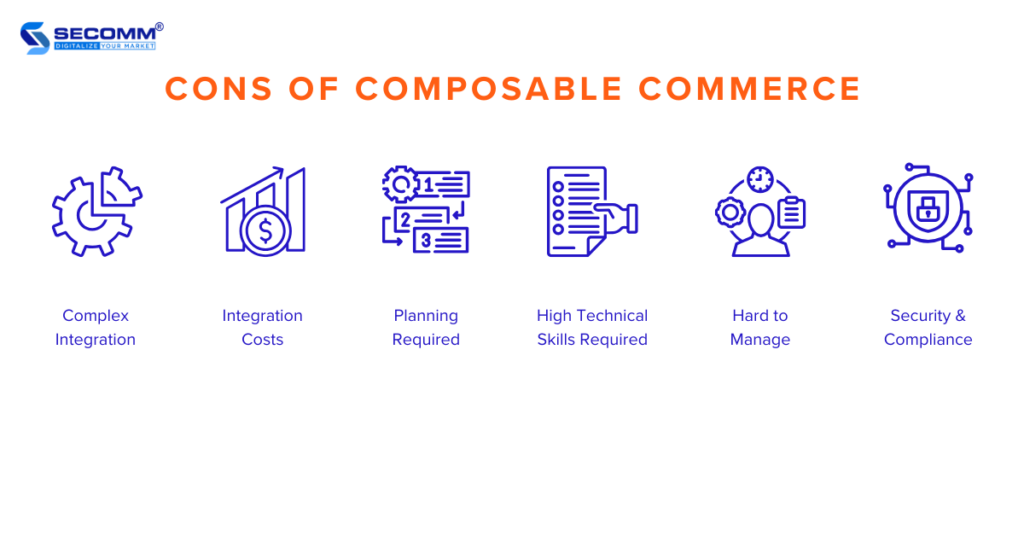
Composable Commerce demands the integration of various components, and this process can be complicated and time-consuming. You’ll need to ensure that these independent components operate seamlessly and efficiently within the same system, requiring additional development and customization efforts.
At scale, the need for deploying a complex system may increase, and integrating multiple components may lead to high upfront and ongoing costs. So, it’s important to phase resources for continuous development, testing, and maintenance of this integrated operation.
Implementing a Composable Commerce architecture requires meticulous planning from the number of components, choice of suppliers, and integrated solutions to issues related to maintaining and upgrading these components.
Building and maintaining an eCommerce system following the Composable Commerce model demands a high level of knowledge and technical skills in various technologies and integrated solutions. You must invest in training your in-house teams or collaborate with highly specialized entities.
Managing a Composable Commerce system can be a significant challenge, especially when you integrate components from multiple 3rd-party suppliers. While Composable Commerce provides flexibility in integration, it also implies that you have to manage relationships with various suppliers.
When there is a need for expansion, you’ll work with these suppliers to ensure each component can scale concurrently and efficiently, avoiding any adverse impact on system development.
Ensuring the security and following rules for many components at the same time can be tricky. Each supplier has their own security and rule needs. So, how can you follow all the rules from each supplier without messing up the way your Composable Commerce system works? – That’s the point!
Both Composable and Headless Commerce architectures separate the frontend and backend, providing a higher level of flexibility and customization. These technology solutions are currently the focus of many large businesses worldwide.
So, what is the main difference between the two?
In the Headless architecture, the separation of the frontend and backend allows you to update and customize either the frontend or backend without affecting each other.
On the other hand, the modular nature of Composable architecture takes it a step further by decoupling all eCommerce components, enabling you to choose and set up perfect PBCs (Packaged Business Capabilities) for your needs.
The key feature of Composable architecture is that, while the frontend can connect to various components at the backend through APIs, these components are highly modular and independent. This means that changes to one component won’t affect other components or the frontend interface.
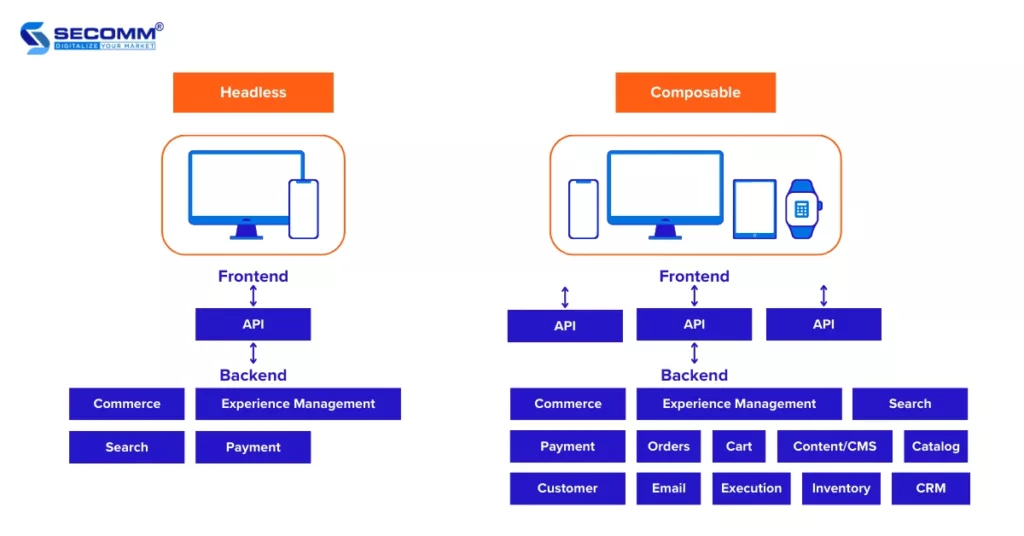
Should we deploy Headless Commerce or Composable Commerce?
When considering the prospects of eCommerce architectures, it is evident that both Composable and Headless Commerce offer superior customization and scalability, allowing you to break free from traditional constraints to adapt to market trends. However, the decision to implement a specific architecture will depend on your business needs, technical expertise, and the goals you want to achieve.
With SECOMM’s extensive expertise and deep experience in successfully deploying numerous Headless Commerce projects, we serve as a reliable partner to advise businesses looking to implement this architecture with innovative solutions.
Contact us or call directly on the hotline at 028 7108 9908 to take a leap forward with SECOMM and unlock the full potential of both Headless and Composable Commerce today!
 2
2
 6,604
6,604
 0
0
 1
1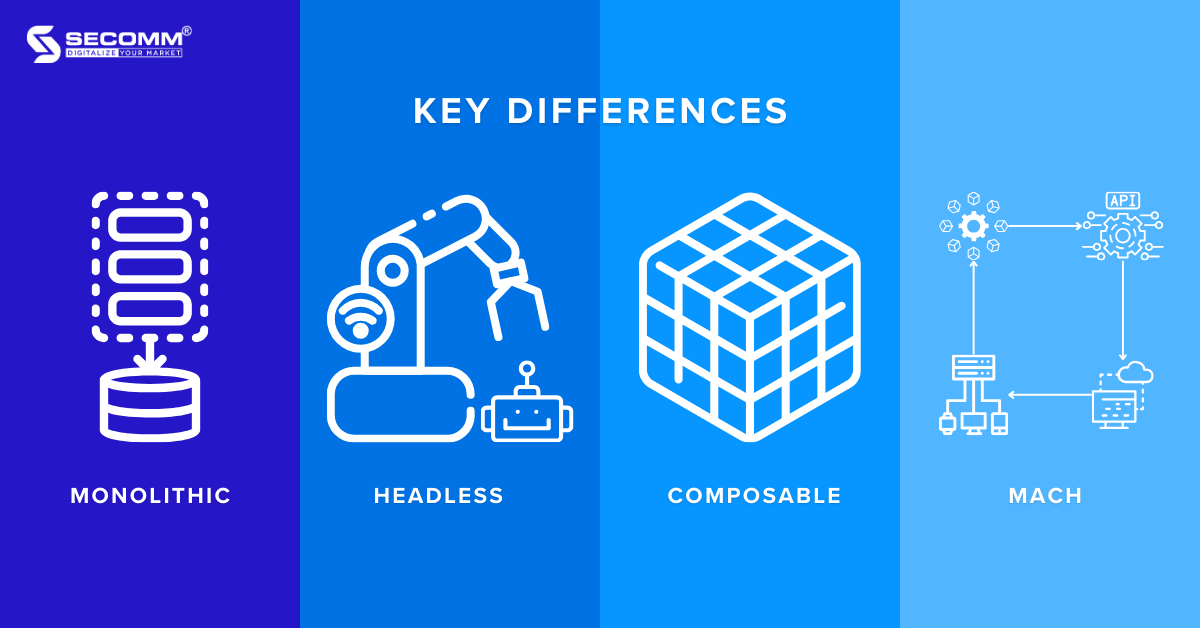
The eCommerce sector is experiencing rapid growth, with global retail sales reaching 5.7 trillion USD in 2022 and projected to hit 6.3 trillion USD in 2023, as reported by Insider Intelligence. This requires businesses to adopt more efficient and flexible eCommerce architectural solutions to meet customer demands for online shopping experiences.
However, there is no one-size-fits-all eCommerce architectural solution. Each architecture comes with its own set of advantages and disadvantages, catering to different goals and requirements. Hence, businesses must discern between eCommerce architectures to choose the most fitting one for their business model.
This article will introduce the four most common eCommerce architectures: Monolithic, Headless, Composable, and MACH. Also, it’ll compare and evaluate these architectures based on criteria such as cost, scalability, customization, security, and performance.
Monolithic architecture is a traditional and long-standing model in eCommerce development. In this approach, the entire eCommerce website is built as a unified application on a single source codebase.
This means that both the user interface (frontend) and business logic (backend) are combined and implemented within a comprehensive “all-in-one” system. So, modifications to specific eCommerce components may have repercussions on the overall functionality of the system.
Pros:
Cons:
The Monolithic architecture can be used in case your business is implementing a small-scale, straightforward eCommerce system, seeking a rapid market launch without immediate plans for significant future development. However, architectures like Headless or Composable would be more appropriate as the system grows and expands, requiring increased customization and scalability
The Headless architecture is a popular architectural solution in eCommerce, where the user interface (frontend) of the eCommerce website is decoupled from the operational system (backend). The Headless architecture is often called “API-first” because the frontend and backend communicate with each other through an API layer.
Many businesses opt for the Headless Commerce model to create and customize user interfaces (frontends) to provide customers with a rich and seamless shopping experience across various channels such as websites, mobile apps, IoT, and POS. These user interfaces can connect to a single backend system through an API layer, enabling businesses to engage in multi-channel commerce and rapidly expand internationally.
Pros:
Cons:
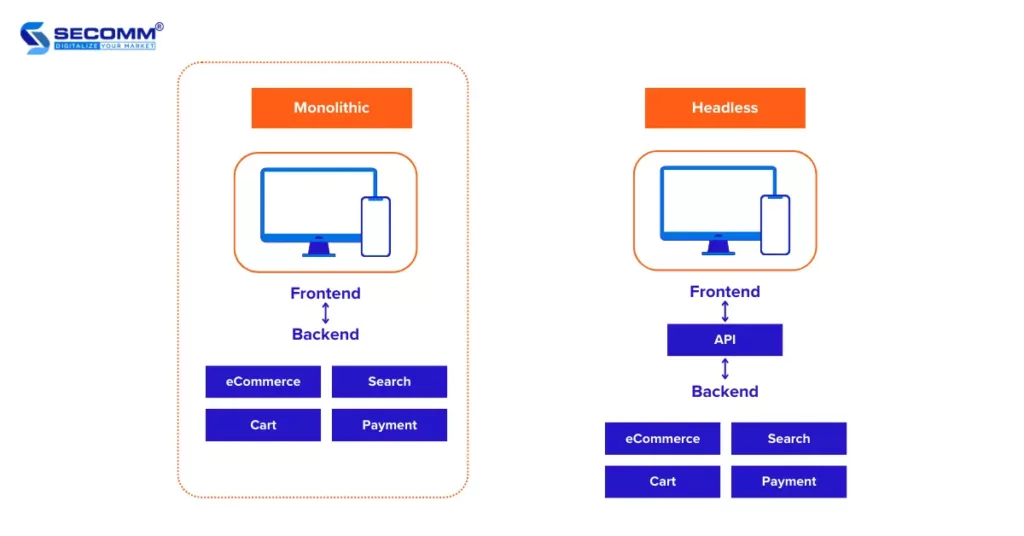
Deploying Headless Commerce may be suitable for businesses that require flexibility to create and customize multiple user interfaces for multi-channel sales purposes and expand their business globally. In particular, businesses that demand independent development of both frontend and backend, as well as the need for integration with various third-party systems, should prioritize the Headless architecture.
If the standout feature of the Headless architecture is the separation of frontend and backend, providing scalability and flexible customization, then the Composable architecture, also known as Module-driven architecture, takes it a step further by decoupling all eCommerce components such as Search, Payment, Cart, etc.
This allows businesses to select components and package them into Packaged Business Capabilities (PBC) to create a specialized and comprehensive eCommerce website solution.
Pros:
Cons:
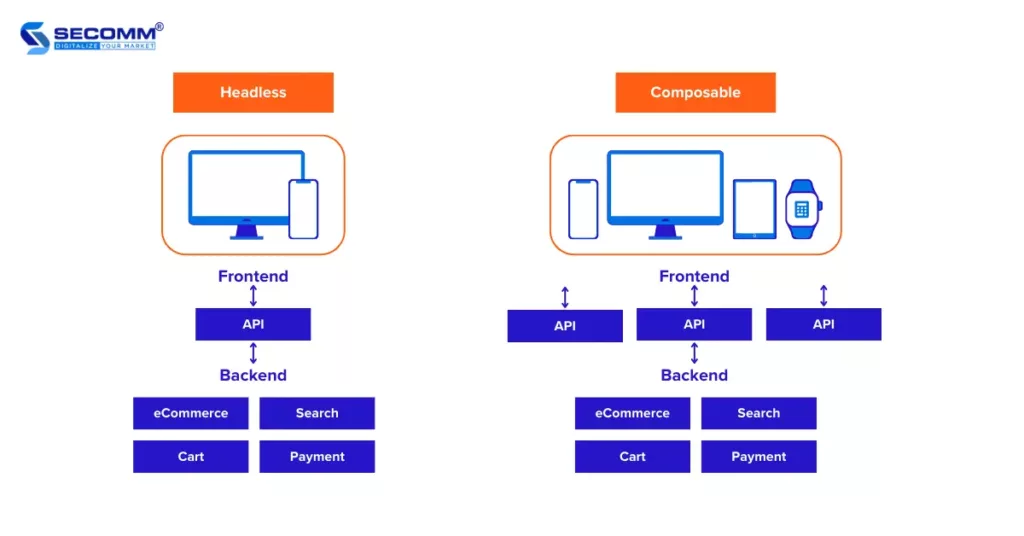
Composable architecture is suitable for cases where businesses undertake large projects, have high demands for flexibility and customization, need to integrate multiple services and third-party systems, as well as require complete independence between the components of the eCommerce system.
The MACH architecture is the most modern approach for building and developing highly flexible eCommerce websites. This architecture allows businesses to integrate leading technologies into a single system, incorporating Microservices-based, API-first, Cloud-native, and Headless components.
Pros:
Cons:
MACH architecture is suitable for businesses with ample budgets aiming to implement large projects based on the four MACH technologies and with high requirements for customization and scalability. It is also beneficial if they have in-house expertise or collaborate with highly specialized development teams.
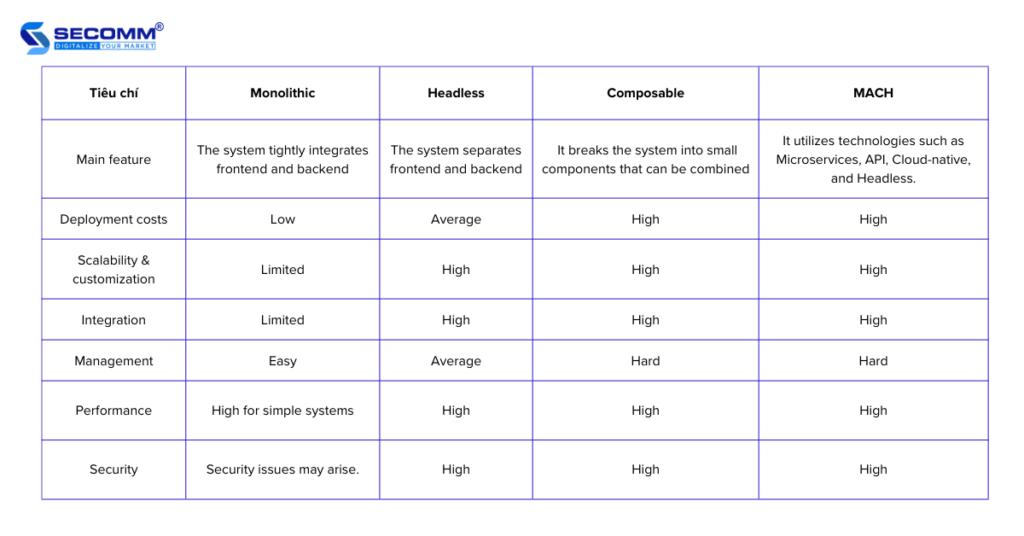
Above is a summary of the essence of the four eCommerce website deployment architectures: Monolithic, Headless, Composable, and MACH. While Monolithic may seem outdated and has many limitations, the Composable and MACH architectures are innovative, providing more optimal and flexible development solutions, but their deployment and operation processes are complex, requiring a highly skilled development team. Therefore, Headless becomes a valuable architectural solution compared to the other three choices for implementing eCommerce websites at the current time.
Headless Commerce is the most popular solution today, with a 25% increase in demand for Headless Commerce deployment in the past two years. Implementing Headless allows businesses to create a customized and multi-channel user experience by integrating with leading tools and technologies. To effectively develop Headless Commerce, businesses need to collaborate with a development team with high skills and expertise, as well as a well-thought-out strategy.
With extensive technical experience and high expertise in the e-commerce field, SECOMM has successfully consulted and implemented Headless Commerce for leading businesses such as Vinamilk, and Suzuverse, based on one of Shopify’s three solutions:
Contact SECOMM or call directly on the hotline (02871089908) to explore how we can support businesses in maximizing the potential of Headless Commerce and enhancing competitiveness in the eCommerce market.
 2
2
 6,401
6,401
 0
0
 1
1Subscribe to get the latest eBook!
Hotline